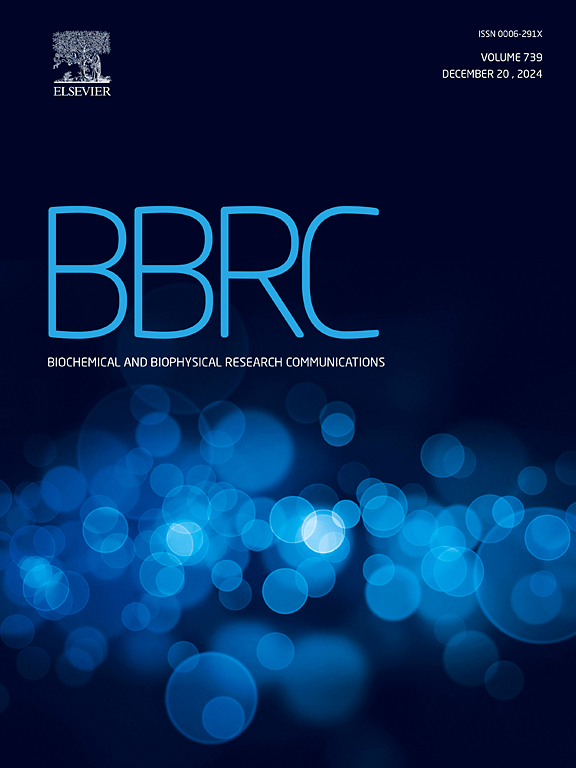NHE9 regulates exosomal stress response to hypoxia in cardiomyocytes
IF 2.2
3区 生物学
Q3 BIOCHEMISTRY & MOLECULAR BIOLOGY
Biochemical and biophysical research communications
Pub Date : 2025-06-10
DOI:10.1016/j.bbrc.2025.152191
引用次数: 0
Abstract
Hypoxia, a major stressor in conditions like ischemia, significantly impacts the function and communication of cardiomyocytes. Cells adapt to hypoxia through various mechanisms, including the release of exosomes. Exosomes are nanoscale vesicles that facilitate intercellular signaling by transferring specific biomolecular cargos. Despite this understanding, the molecules driving these stress responses and the release of exosomes remain unclear. Recent research efforts are focused on identifying the key molecular players involved in exosome release during hypoxic conditions to gain a clearer understanding of these adaptive mechanisms. The endosomal sodium-proton exchanger NHE9 was recently identified as a crucial regulator of exosome biogenesis. In this study, we used human induced pluripotent stem cell-derived cardiomyocytes (iPSC-CMs) and H9c2, a mouse cardiomyocyte cell line as models to show that hypoxia leads to significant upregulation of NHE9. To investigate the role of NHE9 upregulation during hypoxia, we generated genetically engineered cell lines with altered NHE9 expression. We then examined exosome dynamics under hypoxic conditions in cell lines where NHE9 was either overexpressed or knocked down. Exosomes were isolated and characterized using nanoparticle tracking analysis and Western blotting. Our results demonstrate that NHE9 upregulation leads to a significant increase in exosome secretion and enriches these exosomes with stress response proteins, specifically hypoxia-inducible factor 1-alpha (HIF1α) and heat shock protein 70 (Hsp70). Therefore, this study reveals a novel role for NHE9 as a critical regulator of stress signaling in hypoxic environments, offering new insights into cardiomyocyte adaptation and potential therapeutic interventions.
NHE9调节心肌细胞对缺氧的外泌体应激反应
缺氧是缺血等情况下的主要应激源,会显著影响心肌细胞的功能和通讯。细胞通过各种机制适应缺氧,包括释放外泌体。外泌体是纳米级囊泡,通过转移特定的生物分子货物来促进细胞间信号传导。尽管了解了这一点,但驱动这些应激反应和外泌体释放的分子仍不清楚。最近的研究工作集中在确定在缺氧条件下参与外泌体释放的关键分子,以更清楚地了解这些适应机制。内体钠质子交换剂NHE9最近被确定为外泌体生物发生的关键调节剂。在本研究中,我们以人诱导多能干细胞衍生的心肌细胞(iPSC-CMs)和小鼠心肌细胞系H9c2为模型,表明缺氧可导致NHE9的显著上调。为了研究缺氧时NHE9上调的作用,我们构建了NHE9表达改变的基因工程细胞系。然后,我们在NHE9过度表达或敲低的细胞系中检测了缺氧条件下的外泌体动力学。外泌体的分离和表征采用纳米颗粒跟踪分析和Western blotting。我们的研究结果表明,NHE9上调导致外泌体分泌显著增加,并使这些外泌体富含应激反应蛋白,特别是缺氧诱导因子1- α (HIF1α)和热休克蛋白70 (Hsp70)。因此,这项研究揭示了NHE9在缺氧环境中作为应激信号的关键调节因子的新作用,为心肌细胞适应和潜在的治疗干预提供了新的见解。
本文章由计算机程序翻译,如有差异,请以英文原文为准。
求助全文
约1分钟内获得全文
求助全文
来源期刊
CiteScore
6.10
自引率
0.00%
发文量
1400
审稿时长
14 days
期刊介绍:
Biochemical and Biophysical Research Communications is the premier international journal devoted to the very rapid dissemination of timely and significant experimental results in diverse fields of biological research. The development of the "Breakthroughs and Views" section brings the minireview format to the journal, and issues often contain collections of special interest manuscripts. BBRC is published weekly (52 issues/year).Research Areas now include: Biochemistry; biophysics; cell biology; developmental biology; immunology
; molecular biology; neurobiology; plant biology and proteomics

 求助内容:
求助内容: 应助结果提醒方式:
应助结果提醒方式:


